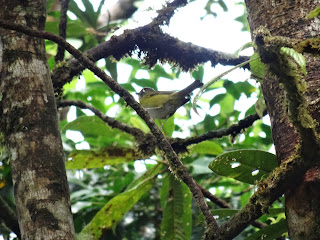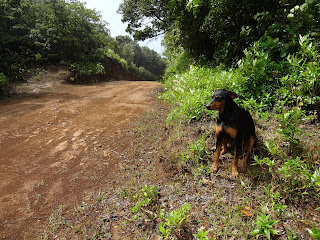The first photo is looking westward toward the Gulf of Nicoya from our starting point off the main road.
As the rough looking sign can attest, this isn't really much of a formal tourist attraction.
And what would a hike up Cerro Tres Amigos be without some amigos. These two snuck up on us after we passed on of the last houses and the big guy decided he was going to be the third amigo on our hike.
On dry bluff soils in the roadcut we saw tonnes of these fiery orange orchids known as Ground-rooting Epidendrum or Fire-star Orchid (Epidendrum radicans). Other pink and purple orchids were also perched high up on the roadcut and try as I might to get photos none really turned out.
A shot of the road incline, feel the burn!
While the cloud forest didn't yield a tonne of butterflies, the embankments covered in blooms were rife with butterflies. the lower stretch of the 2.75km hike probably yielded about 35 to 40 species and maybe 200-250 individuals. The breaks to check out the butterflies were welcomed rest stops. The photo below is a Mexican Silverspot.
We saw 2 individuals of this species. It's not listed in the ID materials I have at my disposal and despite scanning Google I can't figure it out. If anyone happens to know feel free to leave a comment!
Common Bush Tanager, one of the most common forest birds of the trip can be easily identified by the white spot behind the eye. Usually we would see them in small groups of 3 or 4. [ebird map]
At one point I spotted a massive tree off to the side of the trail and wanted a photo. This might have been the largest tree we say on the trip; I'm not sure what species it is but the diameter at breast height would appear to be 350-400cm excluding the flaring of the buttress roots. To the immediate left of the tree, the valley drops a steep 75m.
A highlight for the day was coming across this Orange-kneed Tarantula crossing the road. Our curious canine companion wanted to have a look so we had to hold him back while the spider crossed.
I've watched this video so many times, I love the way these creatures move.
Onward and upward. We've left the flowery roadsides, the temperature is dropping and we're getting into the misty elevations of the cloud forest.
Who's your buddy?
A neat looking wasp nest hanging from a branch over the road. We later walked through a section of road with ground-nesting bees everywhere, the large kind that kind of swarm and make you walk a bit faster through the minefield of holes in the ground.
Heading back down the mountain the bright blue fruits of Yerba de Guava (Coccocypselum hirsutum) caught my eye. This species is a member of the Rubiaceae family found from Florida and Mexico through to Brazil.
Another familiar plant, this resembles the Blue-eyed Grass (Sisyrinchium albidum) found in Ontario. This species is Blue Pigroot or Striped Rush-leaf (S. micranthum).
More of the Tropical Milkweed.
We spotted a single Rusty-tipped Page. The combination of nectar plants and the wet clay road (used as a mineral lick) provides the perfect habitat for this and many other butterfly species.
The Black-bordered Tegosa is found from Nicaragua through to Venezuela. After we returned to town we went to 'El Trapiche' to do a tour of a small scale coffee, sugar cane and chocolate plantation. I unfortunately left my camera at the hotel and didn't get shots of Alyssa riding a cart pulled by a couple of ox, but needless to say, we we're buzzing after trying the samples offered at the tour. For the next update we'll move on to Monteverde Reserve.



















No comments:
Post a Comment